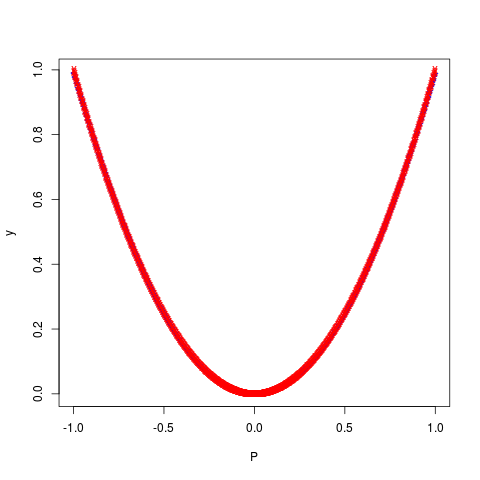Supported by Dr. Osamu Ogasawara and  providing providing  . . |
|
Last data update: 2014.03.03 |
Create a Multilayer Feedforward Neural NetworkDescriptionCreates a feedforward artificial neural network according to the structure established by the AMORE package standard. Usagenewff(n.neurons, learning.rate.global, momentum.global, error.criterium, Stao, hidden.layer, output.layer, method) Arguments
Valuenewff returns a multilayer feedforward neural network object. Author(s)Manuel Castej<c3><83><c2><b3>n Limas. manuel.castejon@gmail.com ReferencesPern<c3><83><c2><ad>a Espinoza, A.V., Ordieres Mer<c3><83><c2><a9>, J.B., Mart<c3><83><c2><ad>nez de Pis<c3><83><c2><b3>n, F.J., Gonz<c3><83><c2><a1>lez Marcos, A. TAO-robust backpropagation learning algorithm. Neural Networks. Vol. 18, Issue 2, pp. 191–204, 2005. See Also
Examples
#Example 1
library(AMORE)
# P is the input vector
P <- matrix(sample(seq(-1,1,length=1000), 1000, replace=FALSE), ncol=1)
# The network will try to approximate the target P^2
target <- P^2
# We create a feedforward network, with two hidden layers.
# The first hidden layer has three neurons and the second has two neurons.
# The hidden layers have got Tansig activation functions and the output layer is Purelin.
net <- newff(n.neurons=c(1,3,2,1), learning.rate.global=1e-2, momentum.global=0.5,
error.criterium="LMS", Stao=NA, hidden.layer="tansig",
output.layer="purelin", method="ADAPTgdwm")
result <- train(net, P, target, error.criterium="LMS", report=TRUE, show.step=100, n.shows=5 )
y <- sim(result$net, P)
plot(P,y, col="blue", pch="+")
points(P,target, col="red", pch="x")
Results
R version 3.3.1 (2016-06-21) -- "Bug in Your Hair"
Copyright (C) 2016 The R Foundation for Statistical Computing
Platform: x86_64-pc-linux-gnu (64-bit)
R is free software and comes with ABSOLUTELY NO WARRANTY.
You are welcome to redistribute it under certain conditions.
Type 'license()' or 'licence()' for distribution details.
R is a collaborative project with many contributors.
Type 'contributors()' for more information and
'citation()' on how to cite R or R packages in publications.
Type 'demo()' for some demos, 'help()' for on-line help, or
'help.start()' for an HTML browser interface to help.
Type 'q()' to quit R.
> library(AMORE)
> png(filename="/home/ddbj/snapshot/RGM3/R_CC/result/AMORE/newff.Rd_%03d_medium.png", width=480, height=480)
> ### Name: newff
> ### Title: Create a Multilayer Feedforward Neural Network
> ### Aliases: newff
> ### Keywords: neural
>
> ### ** Examples
>
> #Example 1
>
> library(AMORE)
> # P is the input vector
> P <- matrix(sample(seq(-1,1,length=1000), 1000, replace=FALSE), ncol=1)
> # The network will try to approximate the target P^2
> target <- P^2
> # We create a feedforward network, with two hidden layers.
> # The first hidden layer has three neurons and the second has two neurons.
> # The hidden layers have got Tansig activation functions and the output layer is Purelin.
> net <- newff(n.neurons=c(1,3,2,1), learning.rate.global=1e-2, momentum.global=0.5,
+ error.criterium="LMS", Stao=NA, hidden.layer="tansig",
+ output.layer="purelin", method="ADAPTgdwm")
> result <- train(net, P, target, error.criterium="LMS", report=TRUE, show.step=100, n.shows=5 )
index.show: 1 LMS 0.0007070751786775
index.show: 2 LMS 0.000215891795660443
index.show: 3 LMS 5.31091712266644e-05
index.show: 4 LMS 8.19184378877529e-06
index.show: 5 LMS 3.13605377993589e-06
> y <- sim(result$net, P)
> plot(P,y, col="blue", pch="+")
> points(P,target, col="red", pch="x")
>
>
>
>
>
> dev.off()
null device
1
>
|
